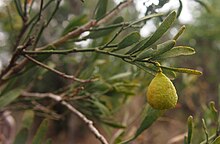|
Australian lime Australian limes are species of the plant genus Citrus that are native to Australia and Papua New Guinea. These species were formerly included in the genera Microcitrus and Eremocitrus.[1][2][3] They have been used as a food source by indigenous Australians and Indigenous New Guineans as well as early settlers and are used in modern Australian cuisine, including marmalade and sauces.[4][5] Species include:
Species from AustraliaNatural species
Cultivars A number of cultivars have been developed in recent years. These can be grafted on to standard citrus rootstocks. They may be grown as ornamental trees in the garden or in containers.[10] Grafted standards are available for some varieties.[1] The cultivars include:
Species from Papua New Guinea
Citrus species in Papua New Guinea have not been extensively studied, so the true number of species is unknown. IdentificationAn identification key Archived 2009-10-02 at the Wayback Machine (p. 6 or 338) exists for the known Australian limes (not including species from Papua New Guinea). The leaves of some species broaden dramatically with age.[19] References
|

